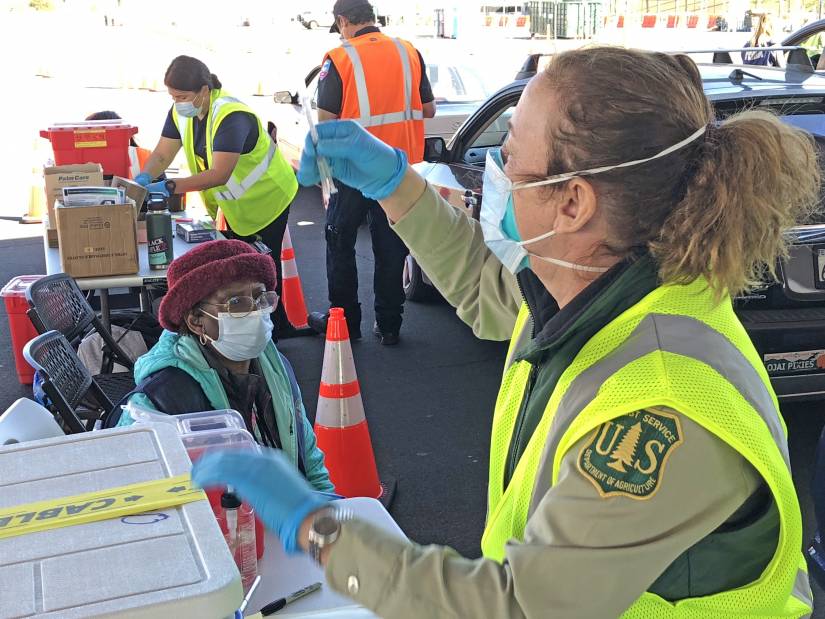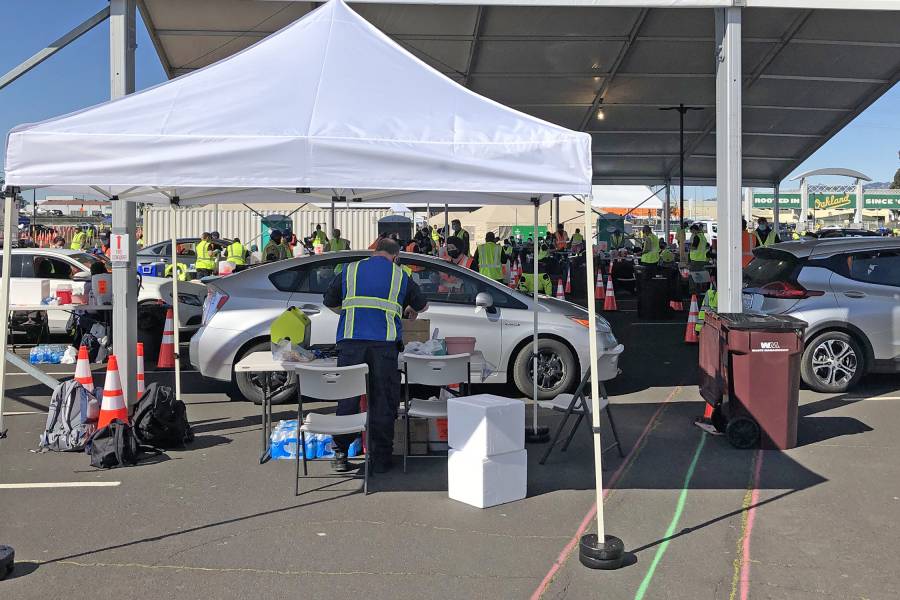Before the COVID-19 pandemic, the U.S. Centers for Disease Control and Prevention was not a commonplace point of reference for the American public, said Rochelle Walensky, who stepped in as director of the CDC in January. "Not everybody in the country before now had even heard of the CDC," she said Tuesday. But now, "we are in the spotlight all the time. Our guidance is in the spotlight."
When Walensky was tapped to head the agency of 20,000 employees in the thick of the largest health crisis of our time, she was prepared for the demands of the job. "I knew it was going to be 24/7 for several years, however long this position will last for me, and I hope it will be a long time," she said. "But I didn't feel I was in a position [where] I could say no when somebody called needing help."

Image caption: Rochelle Walensky
A 1995 graduate of the Johns Hopkins School of Medicine, Walensky returned to her alma mater Tuesday for a conversation with the school's dean of medical faculty, Paul B. Rothman, who is also CEO of Johns Hopkins Medicine, about her first months on the job and the evolving state of the pandemic—and the pandemic response—in the U.S. A full video of the event, part of the Johns Hopkins Health Policy Forum, is available online.
"Rochelle is a pioneering scientist, an influential scholar, and a talented clinician who has served on the front lines during this pandemic," Rothman said.
During her talk, Walensky underscored the severity of the pandemic's impact in the U.S. and the inequities it has revealed. "The country has lost a year of life expectancy in the past year, which is truly extraordinary," she said. Among Black Americans specifically, the life expectancy has dropped 2.7 years, she said, and 1.9 years among Latinos.
"So it's not going to be fixed in a year. It may not be entirely fixed in my tenure," she said. "But I'd love to see the inflection points to finally do something to fix the inequity challenges in this country."
Among other topics, Walensky and Rothman's conversation touched on:
The current state of the pandemic
Though hesitant to issue projections, Walensky said she is cautiously optimistic on the current COVID-19 trends in the U.S. She said the latest daily number of infections and weekly averages are the lowest she's seen on the job, as vaccinations proceed at a rapid clip.
However, Walensky said there's still room for improvement. "We need to do better. I'm not happy at 50,000 cases per day and 600 deaths per day," she said, estimating recent statistics. She added that 40% of U.S. counties still have "extraordinarily high" rates of new cases—more than 100 cases per 100,000 population, she said.
Vaccine progress
The numbers here are impressive, Walensky said: 220 million doses of COVID-19 vaccines delivered within the first 100 days of President Biden's tenure, with roughly 40% of Americans over age 18 now having received full doses. She said 75,000 different venues in the U.S. are now administering vaccines, and 90% of Americans now have access to vaccines within five miles of their home.
Yet the country has reached a point of stasis. "Now we have more doses than people who want it," Walensky said. "We knew we were going to get here."

Image caption: Dana Roth, assistant director for the U.S. Forest Service’s Pacific Southwest Research Station in Albany, California, administers vaccines at the Oakland Coliseum Mass Vaccination Site.
Image credit: USDA Forest Service photo by Paul Wade
To counter the remaining vaccine hesitancy, Walensky said it's crucial to probe at the community level the highly individualized reasons why people aren't getting vaccinated. "Because it's a huge spectrum," she said. "Maybe the people who were offered at first just didn't want to be first. That's fair. It may be they're worried about not having a day off work if they feel unwell. Or it's just been too complicated or hard to get a vaccine."
One thing she hopes to address quickly are concerns over the rapid pace of vaccine development. Walensky said many Americans don't understand the trustworthy scientific context of the two prominent COVID-19 vaccines from Pfizer and Moderna, which are the first mRNA vaccines in public use. "MRNA vaccines have been in the scientific pipeline for decades and we were able to mobilize on this" she said, adding that "100,000 people were enrolled in the clinical safety data we have."
The threat of variants
Variants of the SARS-CoV-2 virus pose the greatest threat to containing the pandemic, not only in the U.S. but globally, Walensky said. "No one is safe until everyone is safe," she said, citing a quote from the World Health Organization.
The CDC anticipated that the B.1.1.7 variant originating from the United Kingdom—known to be 50%-75% more transmissible—would become the dominant variant in the U.S. by spring. "And here we are," Walensky said, with B.1.1.7 now accounting for 59% of genomic sequences across the country. According to Rothman, Hopkins labs have found that B.1.1.7 accounts for 80% of the sequences in Maryland.
"The good news is that our vaccines work against it," Walensky said, and early studies indicate that the variant's threat is "largely undetectable in terms of the survival curve" across ages.
The CDC continues to track other variants internationally, including the B.1.351 variant originating from South Africa and the P.1 originating from Brazil, along with notable variants emerging from U.S. states such as New York and California. "We have every indication that our vaccines should work," Walensky said.
She said her agency is working to better understand the B.1.617 variant driving the recent surge of cases in India, in the context of the two vaccines available there (from Covaxin and AstraZeneca) as well as the U.S. vaccines. "We don't have the data on that," she said. "India has put out a statement that they believe the vaccines are working and we're trying to verify [that]."
Reopening schools
The CDC's expectation is that children will be back to school full-time in the fall, Walensky said, adding: "I think our children depend on it, our mental health depends on it, our society and economy depend on [people] getting back to work."
To ensure safety in schools, Walensky said it's critical to keep COVID-19 case numbers down in communities and enact "layered mitigation strategies," including masking, distancing, hygiene, and contact tracing.
Vaccinations are another piece of the puzzle. So far, Walensky said, more than 2 million U.S. educators have received vaccinations through a federal retail pharmacy program, and 80% of educators have received their first dose. But regardless of where things stand with vaccines, Walensky cautioned that they are not expected to be approved for younger children by fall, so serial testing in schools will be key.
Rebuilding faith in science
Walensky praised the work of Anne Schuchat, who served as principal deputy director of the CDC since 2015. "I asked her before I came to review all the guidance from COVID that [had] been put forward and to make sure that it is written by CDC experts, it is believed by CDC experts … and to really do a thorough comprehensive review of thousands of documents," she said. That process resulted in removal of a total of three documents of guidance, Walensky said, as well a number of updates and "several documents that our subject matter experts felt needed to be worded stronger."
In addition to clearly conveying to Americans the scientific data behind the CDC's recommendations, Walensky said it's been essential to rebuild trust within the agency itself. "I have to communicate back to this incredible agency of scientists that science is going to take precedence again," she said. "We are going to be leading exactly with the science that they produce."
Posted in Health, Politics+Society
Tagged paul rothman, covid-19, covid-19 vaccine, covid-19 variants, rochelle walensky, health policy forum series









